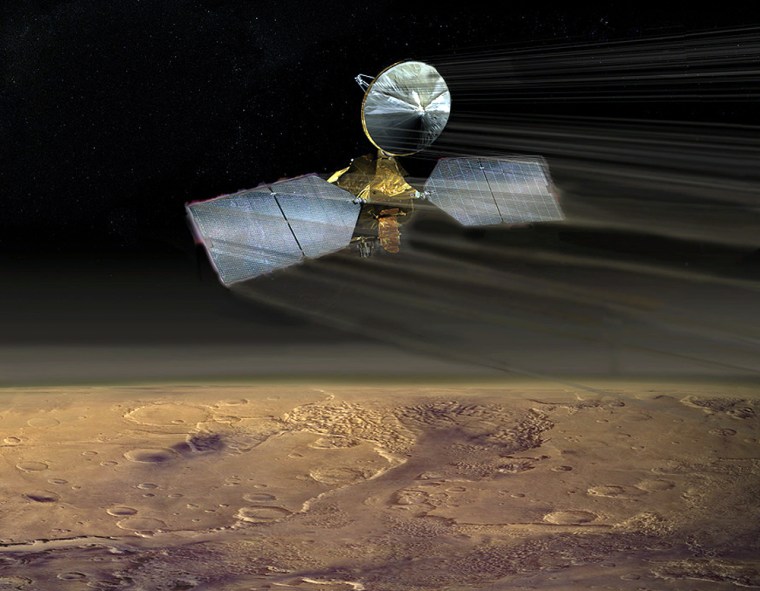Ground controllers on Wednesday successfully performed a major maneuver of NASA’s Mars Reconnaissance Orbiter — an “end game” tactic that puts the orbiting probe a step closer to studying the Red Planet with its entire suite of science sensors.
For months, the MRO has been aerobraking — using the friction of the planet’s thin atmosphere to slow the craft. That technique saves on onboard propellant.
The decision to exit aerobraking was made early Wednesday, noted James Graf, MRO project manager at NASA’s Jet Propulsion Laboratory in Pasadena, Calif. The burn gets MRO out of the atmosphere, with two more maneuvers scheduled over the next two weeks before the spacecraft achieves its science-gathering orbit, he told Space.com.
Spacecraft engineers and navigation experts exploited MRO’s trajectory correction maneuver thrusters, said Wayne Sidney, MRO flight engineering team lead for Lockheed Martin Space Systems, the firm that designed and built the spacecraft in Denver.
Heavy lifting
“I am greatly relieved that the aerobraking phase is over,” Graf explained. “All of aerobraking, but in particular the last demanding week, is dangerous — and it is great to have it behind us.”
Graf saluted a combined JPL and Lockheed Martin Space Systems team that “performed fabulously over the last six months, as did the spacecraft.”
With the heavy lifting of aerobraking behind MRO operators, he said, the spacecraft team is moving on into the transition phase events, which include the commissioning of MRO instruments.
This upcoming phase has its own set of challenges for the team, Graf observed, including the deployment of the Shallow Subsurface Radar antenna and the lid for the Compact Reconnaissance Imaging Spectrometers for Mars, he said.
“The engineering images returned from these instruments at the end of the month should be astounding,” Graf predicted.
Sidney told Space.com that regular MRO burns over the last six months were on the order of seconds. Wednesday's burn lasted several minutes, he said, “the biggest burn just with these TCM engines.”
The burn was executed on time and performance was perfect, Sidney said: “The spacecraft is in great shape. Aerobraking is now officially over.”
There’s still more nudging to do with MRO over the next few months — fine-tuning tweaks that push the probe into its final orbit. The mission’s main science observations are scheduled to begin in November, after a period of intermittent communications while Mars passes nearly behind the sun.
Rock-solid, well-behaved
Overall, MRO is in excellent health, Sidney explained. However, one nagging item cropped up a few weeks ago. A radio frequency switch to flip between MRO’s high- and low-gain antennas is stuck. A tiger team of experts is investigating the issue, trying to ascertain the probable cause of the problem.
“If we don’t get the switch unstuck we’ve lost some redundancy … but we still have the capability to communicate over the low and high-gain antennas using the other transmitter,” Sidney explained. At this point in MRO’s aerobraking campaign, “everything else has been really rock-solid, right on … and gone really well. It has been a remarkable spacecraft. Very well behaved,” he added.
Slideshow 12 photos
Month in Space: January 2014
Dipping in and out of the Martian atmosphere, MRO has seen very few surprises. A worry for aerobraking specialists is encountering dust storm activity that can mix things up in the atmosphere, playing havoc with the delicate spacecraft-slowing maneuvers.
“The atmosphere has been very cold and clear the whole six months as we hoped it would be,” Sidney said.
Launched in August 2005, MRO swung into an elongated orbit around Mars in March of this year.
The $750 million MRO mission is designed to contribute to several science objectives: determine whether life ever arose on Mars; characterize the climate and geology of Mars; as well as prepare of eventual human exploration of the Red Planet.

